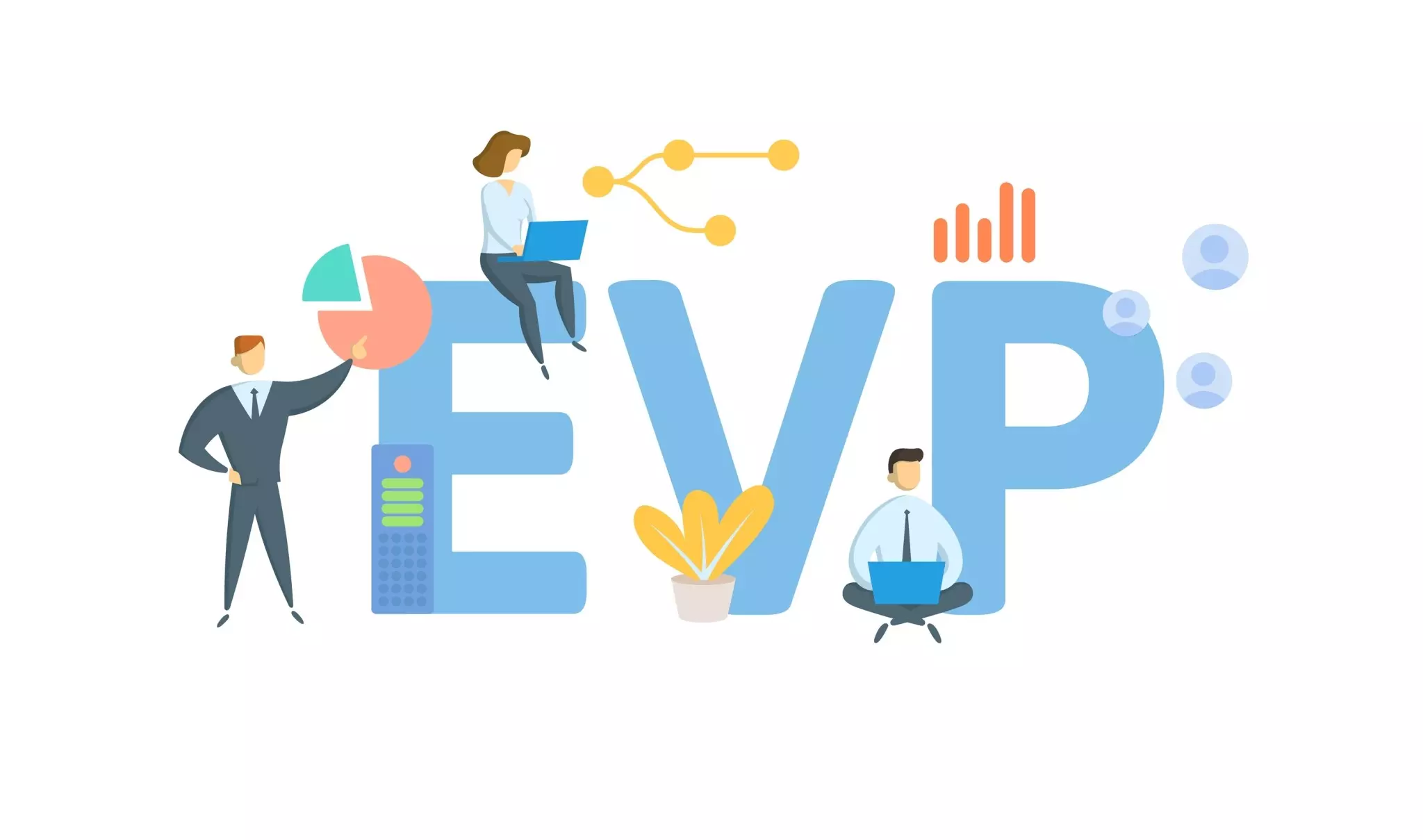Definition
An employee value proposition consists of the incentives and rewards an organization can offer its employees in return for their skills, capabilities, experiences, and performance in the workplace. EVP is the sum of the benefits, perks, and compensation packages your employees can expect. It’s a big part of what makes your organization an enticing workplace for top talent to consider.

EVP is based on an employee-centered approach integrated into workplace planning strategies. It is informed by existing employees and by external target audiences. An employee value proposition must be compelling as it is a crucial driver for attracting and retaining top talent. It is also directly connected with employee engagement.
What is an employee value proposition?
Employees are the backbone of your organization, and you want to be sure your offerings and perks are on par with what scouting talent desires. Therefore, organizations must have a strong employee value proposition (EVP).
But what is an employee value proposition exactly? And why is it critical for any organization to have this critical offering in top shape for prospective talent and existing employees? Let’s explore.
Why organizations should pay attention to EVP
An employee value proposition is vital for attracting, hiring, and retaining new workers. It can be the dividing line that differentiates your organization as “the” place to work or mark it as one to avoid. An EVP communicates a lot to job scouts, including why your organization is better than competing offers and why talent will be happier working for you.
And EVP is about more than just monetary compensation. An employee who feels valued tends to be more engaged in the workplace. They are more productive and determined to help meet your organization’s goals. A unique EVP sets the tone for the overall employee experience, and it’s something to get ahead of, as it can typically be teased out of current employees after a brief conversation about your organization.
Here are reasons why an exceptional employee value proposition matters:
Reduces employee turnover
According to Gartner, “Organizations that effectively deliver on EVP can reduce annual employee turnover by 69%.”
Improves profits
Because an EVP reduces turnover, organizations aren’t wasting money courting new hires. And LinkedIn found that investing in an employee value proposition can save companies $13 million per year.
Builds an inclusive workplace
Talent is increasingly searching for more inclusive and diverse workplaces. A survey by Glassdoor found that “more than 3 in 4 employees and job seekers (76%) report a diverse workforce is an important factor when evaluating companies and job offers.” An organization that values these elements empowers employees from all backgrounds to bring their whole selves, as they are, to work. Building this type of culture breaks down barriers in the workplace and strengthens employee and organizational performance.
Offers a great employee experience
Your employees’ experiences are defined by how they experience your company—from co-workers to digital workplace tools and company culture. Organizations can strengthen their EVP by delivering on what Gartner is calling “the new human deal.” It encompasses five attributes: deeper connections, extreme flexibility, personal growth, holistic well-being, and shared purpose. Employee satisfaction with an organization’s EVP increases by 15% when it encompasses the human deal.
So, if you take the time to develop an EVP and follow through on your promises, employee experience improves.
Take a closer look at why an employee value proposition is essential to your organization.
Why an organization’s value proposition is important
A strong EVP helps attract and retain top talent with values that reflect your own. This alignment ensures they’ll be a good fit and help advance your mission in meaningful ways. It will also result in employees excitedly sharing this EVP they’re so invested in supporting, thus making your organization a desirable workplace and amplifying awareness to other top candidates.
75% of active job seekers are more likely to apply for a job if the organization actively manages its employer brand—including its employee value proposition. And top talent is looking for organizations that fit specific criteria, as they can be discerning thanks to the current job market.
A study on EVP by Gartner found that organizations that effectively deliver on their EVP can increase new hire commitment by nearly 30%.

Employees talk with everyone about their work experience—friends, family, and even the odd stranger at a coffee shop. If they’re going to talk, you want those conversations to be positive, as word of mouth is still the best advertisement!
What makes a compelling EVP
There are many ways to make an employee value proposition stand out. But there are a few key elements you’ll want to include. These are:
Compensation
Monetary compensation is a given, but rewards like stock options, regular raises, and bonuses are an expected part of an EVP.
Benefits
Talent searches for personalized benefits that fit their lifestyle. These employment benefits may look different from organization to organization. Still, they include the basics like paid time off, health insurance, wellness programs, retirement funds, parental leave, company-sponsored holidays, retirement plans, reimbursed extended parental leave and on-site daycare, and unlimited time off.
Career development
Potential employees want to have the opportunity to learn more and advance in the organization, so having career growth opportunities is vital to an EVP. Career development and general employee development opportunities may include leadership training, mentorship programs, promotions, technical training, paid educational courses, travel opportunities, tuition reimbursement, or regular advertisements.
Perks
Everyone loves a good bonus, and employees are no different. Employee value proposition perks include gym memberships, discount cards, free coffee, free meals, snacks, team-building activities, employee trivia night, etc.
Positive employee experience
A positive work environment should focus on the needs of an employee, providing flexible hours, remote work opportunities, employee well-being checks, a comfortable work/life balance, and modern workplace technology. And a positive work environment should also provide autonomy and recognition for a job well done.
Positive culture
Lastly, organizations should take a long, hard look at their culture. What does it say about them? Modern company culture should include diversity, equity, and inclusion. Your organization’s culture should reflect your goals and values and be evident in how you communicate and collaborate. It should foster a positive relationship between team members and supervisors.
Real-world EVP examples
There are always examples to look to for inspiration. Below are a few real-world examples of EVP that prove an employee value proposition is worth the investment.
NIKE
Nike does everything with a “win as a team” approach. And this sentiment permeates their employee value proposition. Nike’s culture emphasizes innovation and approaches its benefits and compensation similarly. As a result, the company offers perks like relocation benefits, advanced learning opportunities, fitness discounts, competitive pay, retirement plans, and more.
LinkedIn’s slogan is #LinkedInLife. They encourage employees to post about the company culture as they’re confident they’re offering employees the best experience possible. LinkedIn provides several benefits spanning different categories, such as health, family, passion, must-haves, and extras. LinkedIn has comprehensive benefits and a compensation package covering childcare, eldercare, and pet care subsidies. Additionally, they provide education reimbursement and life insurance. And at the end of the year, LinkedIn employees get paid to shut down while the company closes and celebrates.
Airbnb
“Create a world where anyone can belong anywhere.” This is Airbnb’s mission. And it is supported by their core values which champion inclusivity, caring, support, and innovation. And their employee value proposition fits in with their business objective—to host a travel community of guests and hosts on an inclusive platform. Being a travel company, it’s no wonder that Airbnb offers travel-friendly benefits, like annual travel, “experiences” credit, and paid volunteer time.
How to define your EVP
Every organization differs and will offer other things according to its objectives, mottos, purpose and mission. Creating an employee value proposition based on someone else’s could be disastrous. Instead, each organization needs to find what works for it, and here are the steps to do so.
1. Assess your current offerings
Before doing anything, you need to examine your organization’s current offers. Please take note of your current benefits, perks, compensation, strong work culture, and any other opportunities your organization currently provides its employees.
And this step will be a recurring one. As your company grows and evolves, it will become necessary to revisit these items to see if they still reflect your values as an organization.
2. Make a list of qualities your ideal employees have
What are the ideal qualities you’d like to have in an employee? Along with leadership, sit down and look at the qualities you desire in candidates you recruit. In this list, you should have any skills, traits, and characteristics of the ideal employee. These traits could include:
- Motivated
- Passionate to learn
- Self-starting
- Creative
When you know what you want in an employee, you can center your EVP around them. For example, if you’re looking for employees who are passionate about learning, offering exceptional training and career development opportunities that go above and beyond the norm and stressing its importance during the interview process will weed out those who aren’t a good fit and attract candidates eager to learn and grow.
3. Conduct surveys with current employees
It would be best if you did not create an employee value proposition without your current employees in mind, or you risk losing them. Creating an employee experience survey asking your employees what they like about your organization and what they would change should inform your EVP planning.

This can also help retain employees currently exploring other opportunities as they search for specific perks or benefits you hadn’t considered a priority. There may be questions that are more specific to your organization, but some simple starter questions could be:
- What do you enjoy the most about working here?
- What are some of your favorite benefits or perks that we currently provide?
- Are there opportunities you wish we could provide? What are they?
- Is your career path at our organization clear?
- How does your work contribute to our success?
- How can we provide additional support to enhance your work with us or advance your understanding?
- Do you have the necessary digital workplace tools to support you?
- Do you feel heard and valued as an employee? How can we improve this?
Another way to get this information is to conduct exit interviews—this feedback is instrumental as employees leaving a company will be less filtered in their responses. But this is also a time when it’s too late to repair relationships that could have been saved.
Check out our blog for employee engagement survey question ideas
4. Personalize your EVP to match your candidate pool
Many job functions exist, so your employee value proposition should cater to these various audiences. The EVP should be all-encompassing but stress different aspects based on the candidate you seek. For example, suppose you need a creative candidate for a marketing position—they would be much more interested in the social sharing tools you have available than sales bonuses that apply to an entirely different department. The same is valid for continuing education opportunities for greener workers versus participating in industry events where experienced practitioners network.
Depending on the role in question, organizations that showcase relevant EVP components attract the highest caliber of candidates.
5. Communicate your EVP
After you’ve defined your EVP, it’s time to communicate it to internal and external audiences, and there are a few ways you can do this:
- Message it out internally via employee newsletters
- Include it in your job descriptions
- Publish it on your company website
- Emphasize it during the interview process and in job offer letters
- Promote it on your social media accounts
- Share it with headhunters who typically connect top candidates with HR
One final note on creating an EVP: The goal is to help you attract, hire and retain talent that aligns with your organization’s goals and values—so your company’s unique values and differentiators must be clear.
If you need help building a better employee experience and cohesive company culture as a part of your employee value proposition, reach out for a demo!

Watch a 5-minute demo
See how the Simpplr employee experience platform connects, engages and empowers your workforce.
- #1 Leader in the Gartner Magic Quadrant™
- 90%+ Employee adoption rate







